It is relatively easy to report on current and historical costs
of the physical ingredients that drive steel prices but this All Steels bulletin
steps over this boundary by making bold predictions on forwarding price direction. These forecasts are all logically based on
analytical trends, sentiment and anecdotal evidence collected from a wide base
of trusted industrial contacts.
At the outset of this year, the impact of Omicron created
massive uncertainty with such a high spread of infections. However, whilst this has most certainly curtailed
industrial consumption of steel during the early part of January, Omicron
aftereffects now appear to be fizzling out, which should allow a steel business
recovery.
It is still All Steels’ view that the rapid acceleration of
steel prices during January -June 2021 were totally justified as steelmaking
costs necessitated such price movement. When we reflect on the data
available however it is clear to see that a lot of the demand during this
period was artificial with companies throughout the industry re-stocking from a
very low base. True underlying demand
was therefore hidden and very much exaggerated by heavy inter-trade volumes
within the stockholding and dockside trading community. It was this
activity that forced steel prices up a notch too far over the summer and by
September steel traders and stockholders woke up to this reality, and demand on
the mills rapidly diminished causing a price softening. Much of Q4, 2021
was therefore a period of market correction as the industry tried to rebalance
stocks to reflect true underlying demand and we believe it is fair to say that this
correction process is still spilling over into Q1, 2022.
It is also worthy of note that as part of this stock
rebalancing process many mills did cut back capacity during Q4 and are still
operating at reduced levels, so the supply and demand balance is not too out of
kilter, and this is what has helped to avoid a boom-and-bust cycle like
historical experiences. As previously expressed, it is always the supply
and demand balance that dictates prices, and therefore we saw rates softening
in Q4, but the All Steels current view is that sentiment has largely
improved. Moreover, stocks will get into balance by the end of February
2022 and with the impact of Omicron expected to moderate many of the large
infrastructure projects planned for the UK will finally take off.
As All Steels, we have already seen evidence of steel
buying to cover very large rail-related projects coming to fruition, but you
can also see from construction media reports produced by the likes of Barbour
ABI and Glenigan that the 2022/23 outlook for the construction industry is very
strong. Only this weekend news was released of electric vehicle battery
start-up, Britishvolt securing £1.7 billion of funding to build a new factory
in the North East that even makes an Amazon Warehouse look small all of which
will consume a massive amount of steel to build the new factory.
The forecast for 2022 construction growth is circa 7%
largely created by public sector investment. It is also fair to say that
construction was also constrained during 2021 by the general tight availability
of building materials so many of last year’s construction projects will spill
over into 2022. Much of the supply flow should improve this year allowing
the construction industry to flourish although optimism probably still needs to
be tempered as labour availability is expected to remain tight. Having
said the latter industrial buildings in the construction sector which is one of
the key focus areas for steel consumption is forecast to grow by a staggering
24% during 2022.
Whilst we are confident that steel buying activity will be
strong in the months ahead off the back of the improved sentiment and more
imbalanced stock levels many of the steelmaking cost drivers appear to be
creating a necessity for mills to increase prices further. It would therefore appear that we could be on
course for another re-run of 2021. The only variance this time is that a much
higher steel price base should avoid excessive speculative buying, and this
should logically result in a smoother rising of steel prices rather than the
big leaps we experienced last year.
Hopefully, our opening message above gives a flavour of what
we should expect but here are some of the updated data on steelmaking
ingredients that force mill price changes which reinforce some of the positive
sentiment messages already expressed.
Coking Coal
0.7 tonne used to make a tonne of steel
The recent movement in coking coal prices has remained
under the radar but the new up spin must start to feature in the coming weeks' steel
journals as prices are now at record-breaking levels. It will be renewed
buying activity that has probably been the catalyst for change as Chinese
steelmakers return to the market to build up raw material inventories ready to
increase production immediately after the Beijing Winter Olympics that
concludes on 20 February 2022.
It is also understood that supply disruption currently
exists in some of the major metallurgical coal mines. Trade flows are
also being hampered by rail transfer constraints from mines to the ports.
One such example was caused by an explosion at a coal transfer station in the
US at the Curtis Nay terminal in late December that is one of the main handlers
of this commodity.
The graph below clearly shows the impact for BOS route
steelmakers. Whilst the graph below shows Chinese domestic price movement
the more highly transacted Australian seaborne coking coal hit a historic record
high of $445 per tonne FOB Australia on Friday after a $15 per tonne daily
jump.
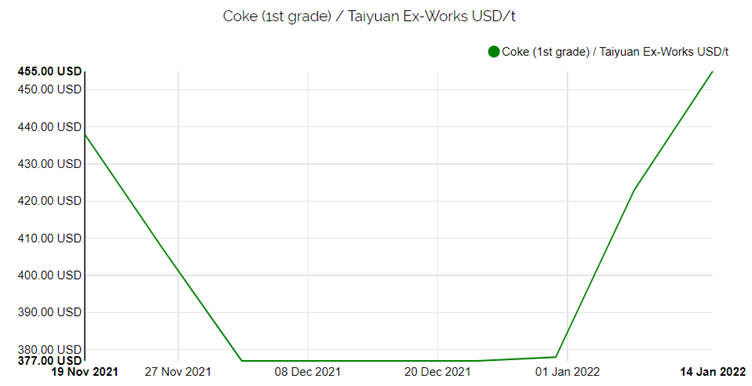
Iron Ore
1.7ttonne used to make a tonne of steel
As conveyed in the coking coal section the increased
Chinese buying activity will also be the probable cause for the recent push up in
iron ore prices and with restocking continuing over the coming weeks, we will
probably see little change to the upward price pressure. This is
surprising news for many pundits that were speculating that iron ore would
remain in the zone of $80-$100 per tonne although it is perhaps the heavy
resumption of steel production planned in China that is likely to have caught
the market by surprise. Such planned growth in steel output obviously questions
China’s commitment to environmental improvements.
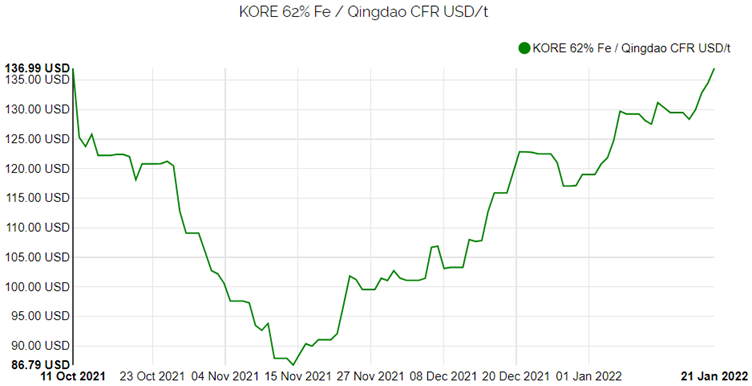
Scrap
tonne used to make a tonne of steel
Scrap rates in Turkey always provide one of the best barometers
for assessing steel prices as the speed of change is always most reactive to
sentiment so it provides excellent direction on future steel prices. The
graph below nicely depicts steel price movement through the pandemic industrial
recovery, but it is the current month's price bounce that should be
spotlighted. The All Steels view is that this immediate curve would have
shown a higher price trend if production output in Turkey had not been
constrained by energy issues which are explained below, nevertheless, this
upward movement must be one of the early signs of another strengthening in
steel prices.
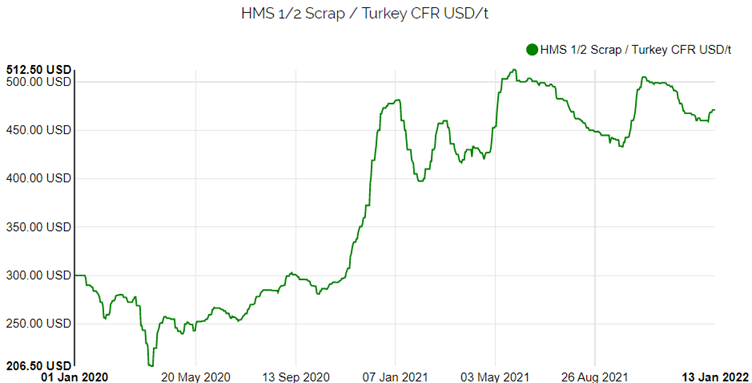
Energy
The cost of gas and electricity remains hot news around the
world and whilst we thought the problem to be just a winter spike issue the
fundamentals would now suggest that high energy costs are likely to remain firm
well into 2023. There are many reports in the public domain produced by energy
brokers and leading utility suppliers to justify the high prices and the table below nicely summarises the factors, reasons and resolution timeframes concerning the UK.
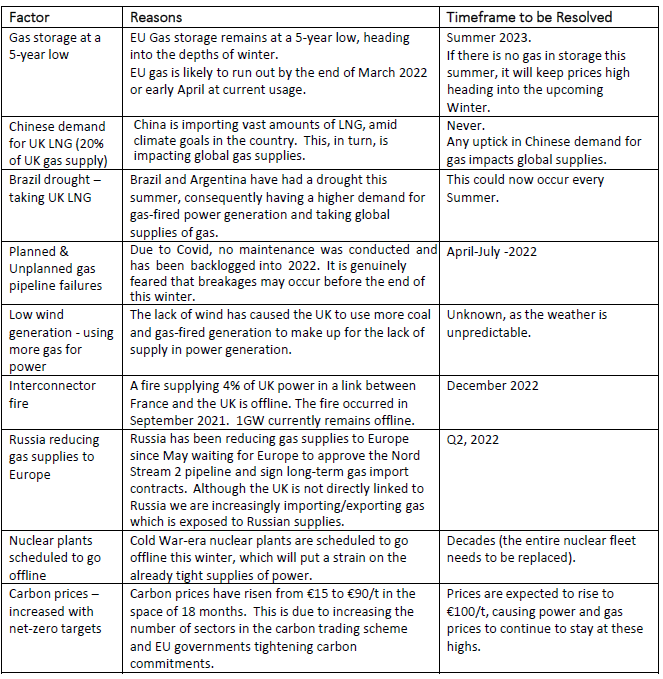
Further afield in Turkey both gas and electric shortages are
so bad that virtually all producers are having to regularly cut output. In the Izmir region for the week ahead, there
are three full days of government-enforced steelmaking closures.
Shipping Prices
The shipping cost of bulk raw materials such as
metallurgical coal /iron ore fell away sharply in Q4, but this was
understandably a reaction to a lack of raw materials flowing into China during
this period as government pressure dictated a cut in steelmaking
capacity. As reported early however Chinese high volume steel production
looks set to come back on stream for the second half of Q1 and just like coking
coal and iron ore prices must be set to rise.
Looking more locally on typical 2,000-3,000t shipload
quantities that service the UK there is no relaxation in shipping prices.
In our last UK steel market evaluation, we reported that we had seen shipping
costs from Turkey increase by $70 per tonne during the period April 2021 to
September 2021. We can now confirm that the shipping costs on our
December inbound material from Turkey increased by another $30 per tonne to
$150 per tonne. What is even more disconcerting is that our main Turkish
hollow section supplier is now indicating that the forward price for Q2 could
be as high as $190 per tonne.
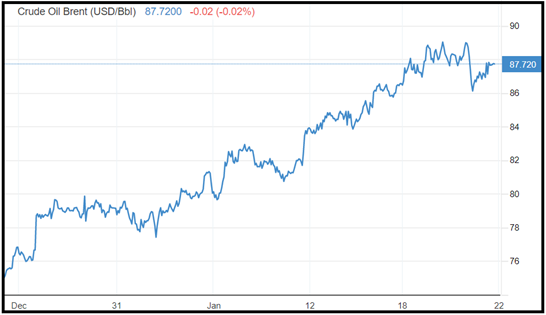
EU suppliers on shorter shipments from Germany, Italy and
Spain are also experiencing a similar surge in costs and on cargo we have just
booked from Italy we have seen a shipping rate increase from September 2021 to
January 2022 of Euro 60 per tonne.
At present we really can’t see any softening in shipping
rates and when you consider that EU steel activity looks set to increase and
marine diesel costs simply follow oil prices that are still trending upwards as
shown in the graph even higher shipping costs look most likely.
Port Congestion
All UK docks remain congested and the peaks and troughs in
trade flows are now creating total mayhem as all importers try to de-risk by advance
bonding material for longer periods at the ports in preparation for the onset
of each new quarter. This is also being compounded by imports increasing
to reflect demand growth and volumes to substitute the loss of domestic supply (left
by large voids due to cuts in capacity to the market by the Liberty Steel Group
particularly on engineering bar supplies).
The overload in the material at the ports is now commonly
resulting in material being block stowed to maximise floor space capacity but
the negatively of this action results in severe delays for material to become
unscrambled for despatch after customs clearance. In some cases, delays
of 4-6 weeks are being experienced. Moreover, due to such huge loadings on
the ports, many have increased storage charges over the last six months from a
low of 25p per tonne per week up to new highs of £2 per tonne per week.
Transport
The good news here is that transport availability
constraints seem to have eased but we must recognise that this is against a
background of lower trade activity in Q4 as the supply chain attempted to
reduce stocks. As we progress through Q1 and into Q2 buying activity and
real underlying demand are all forecast to increase so tight transport problems
are very likely to materialise once again. Even with lower activity, the
cost of transport has remained expensive and with fuel prices yet again rising
we should probably expect more increases in transport costs especially given
that diesel prices continue to move up.
Inflation (Finance)
High inflation levels have already resulted in one recent
bank base rate increase and whilst this movement was small the movement is more
impacting in today’s world of steel with material costs being so high.
More bank rate increases will inevitably be seen in 2022 and whilst this will
add greater cost to the financing of steel inventories it will create wage
pressure, adding even more costs to steel prices in an industry that is still heavily
labour intensive.
EU Carbon Permits
Since our September report, the cost of Carbon Permits has
advanced by another €21 per tonne to a new record high of €85.80 per
tonne. Such a rise impacts utility costs as referenced above but the
bearing on steel prices through environmental taxes is more direct.
All steel producers are on a path aiming for net-zero
carbon emissions but for many, this will take decades to be realised. In
the short term on capacity exceeding carbon allocations blast furnace operators
must buy 2t of CO2 for each tonne of steel produced whereas electric
arc manufacturers depending on the efficiency of their plant must buy 0.5-0.8t
of CO2 for each tonne of steel manufactured. As can be seen from the graph below these
costs were insignificant 12 months ago but the impact today is very significant
and with the cost of carbon permits continuing to rise this will just become an
even bigger cost for those plants that fail to reduce carbon emissions.
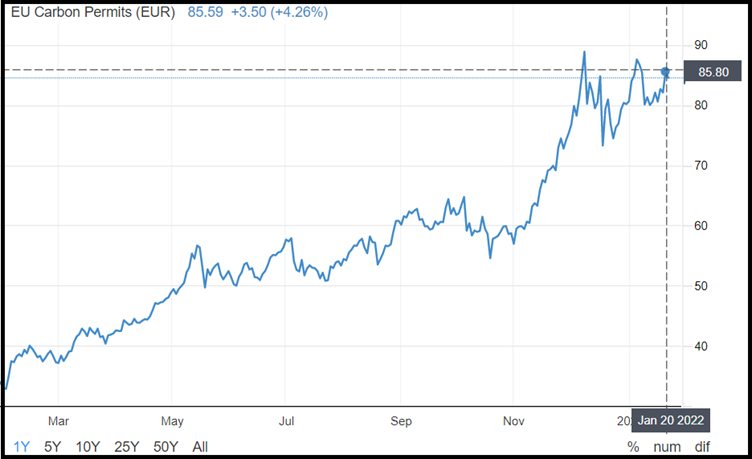
In blast furnace production the carbon tariff escalation
cost adds €171.60 per tonne to steel manufacturing costs (£143.60p per
tonne). In EAF manufacture the cost is somewhere between €42.90p -
€68.64p per tonne.
UK Safeguard Duties
Safeguard duties seem to be
impacting more of our inbound supplies and the cost of such duties are now
becoming more punishing as it is a percentage charge on what are
ever-increasing steel prices. We are also finding that HMRC’s
administration of quota monitoring and reporting is becoming so bad that
traders are losing visibility as to when quotas become exhausted and by what level
thresholds have been exceeded.
New rules on category 12
(effectively merchant bar/engineering bar) have tried to split out these
products into two separate categories through chemical composition rules but
material intended as general structural steel supply is regularly falling into
the engineering bar classification due to high residuals such as copper. Consequently, customs clearance is in total
disarray.
On truckloads, this confusion has
caused serious delays on customs clearances all of which adds to transport
demurrage costs. The big issue here however is that as a mass importer of
steel, as of today (23-1-22), we have no idea of our duty liability on material
customs cleared on 1 January 22 and little clarity on what quota, if
any, remains available in products that we are landing in the UK during the
coming week.
Conclusion
There are many other factors that
we could report upon all of which are upwardly affecting steel prices but, in
this report, we have simply tried to focus on just the main steel price
influencers. We could for example expand
on energy and steel price inflation caused by the threat of war between
Russia/Ukraine that would have an unbelievable impact, but this would be
speculative whereas we are just choosing to report on actual known facts.
As a steel trader that takes
large stock positions the fear of a price crash is our biggest risk/concern and
the reason why we must analyse steel price influencers in such detail. It is against this background that we have
resumed buying heavily for our Q2 requirement despite the high prevailing steel
prices. We recommend that you take a pragmatic
view on the data presented here, and make sure that you are reflecting
anticipated replacement prices on the extremely valuable stock you hold for
sale.